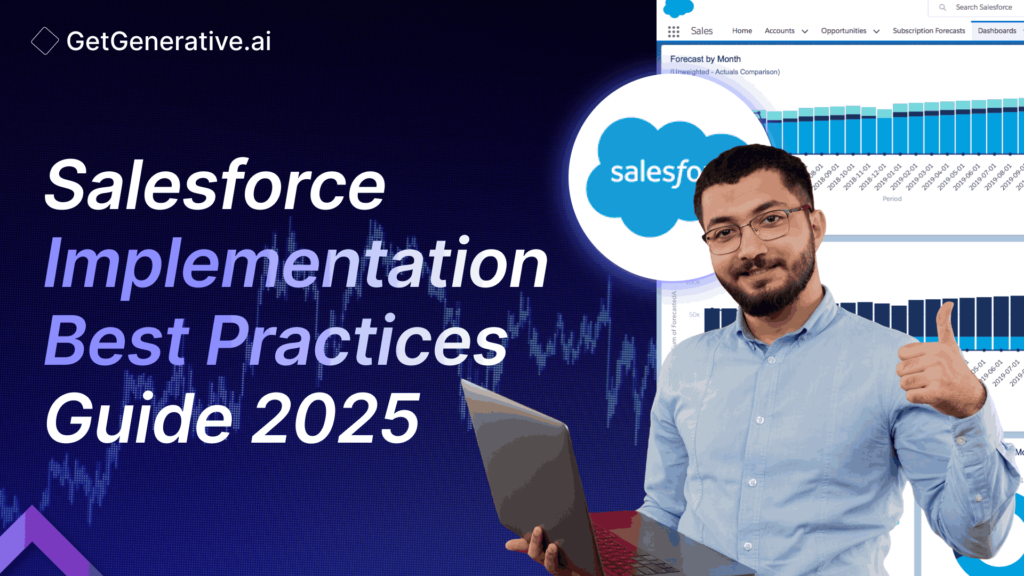Salesforce Implementation Best Practices Guide 2025
Implementing Salesforce effectively is essential for businesses aiming to enhance operational efficiency and foster strong customer relationships. In 2025, with numerous tools and customizable options, Salesforce can transform your processes—but only when implemented correctly.
In this guide, we’ll explore best practices to ensure a successful Salesforce implementation that drives long-term value for your organization.
What Is Salesforce Implementation?
Salesforce implementation refers to the strategic setup and integration of Salesforce into your organization’s workflows. It includes assessing business needs, customizing features, migrating data, training users, and continuous improvement. Effective implementation aligns Salesforce functionalities with your objectives, ensuring a smooth transition and maximizing the CRM’s potential.
Why Is Successful Salesforce Implementation Crucial?
Salesforce’s versatility allows it to serve various business needs, from customer service to marketing automation. However, without a proper implementation strategy, companies risk underutilizing its capabilities. A well-planned implementation can help streamline processes, improve data accuracy, foster collaboration, and elevate customer engagement—all key to sustained growth.
Also Read – Salesforce Einstein Implementation Guide
Salesforce Implementation Best Practices
1. Define Clear Business Goals
Start with a solid understanding of your goals. Do you aim to increase sales, improve customer support, or optimize marketing efforts? Clear goals guide every implementation step, from selecting features to setting performance indicators. Aligning Salesforce with your business strategy ensures that every tool you use contributes to achieving your objectives.
2. Select the Right Salesforce Edition and Product
Salesforce offers multiple editions and products, each catering to specific business needs. For instance:
- Essentials for small businesses needing core CRM functionalities.
- Professional for growing businesses seeking more customization.
- Enterprise for larger organizations needing complex workflows.
- Unlimited for companies that need access to all Salesforce tools.
Selecting the right edition helps you avoid unnecessary costs and provides the tools essential to your goals.
3. Develop a Detailed Implementation Plan
A comprehensive plan serves as your roadmap, covering milestones, team roles, budget, and timelines. An effective plan includes:
- Team Structure: Define roles, including project manager, Salesforce admin, and data migration specialist.
- Budget Allocation: Prepare for costs related to licenses, customization, data migration, and ongoing support.
- Timeline: Set realistic timelines for each implementation phase, including configuration, testing, and launch.
A structured plan keeps the project on track and helps manage resources efficiently.
4. Engage a Salesforce Implementation Partner
Working with a certified Salesforce implementation partner provides access to expertise that can save time and avoid pitfalls. Partners bring knowledge of best practices and industry insights, helping tailor Salesforce to your needs. They also offer support post-launch, which is essential for continuous improvement.
5. Prioritize Data Quality and Migration
Data is the backbone of any CRM. Before migrating to Salesforce, clean your data to remove duplicates and outdated entries. Establish data management standards such as naming conventions and validation rules to ensure consistency. Proper data quality measures improve CRM reliability and help users make data-driven decisions confidently.
6. Customize Salesforce to Align with Business Needs
Salesforce’s customization options are extensive, but it’s crucial to use them wisely. Avoid over-customization, which can clutter the platform and complicate workflows. Instead, focus on custom fields, objects, and workflows that align closely with your core processes. Customization should streamline operations, not add complexity.
7. Implement Automation and AI for Efficiency
Salesforce offers powerful automation tools, such as Flow Builder, to help streamline repetitive tasks. Automating workflows reduces manual errors, speeds up processes, and allows your team to focus on strategic activities. Additionally, leveraging AI-driven insights from Salesforce’s Einstein Analytics can enhance decision-making, providing predictive insights and trend forecasts.
8. Conduct Thorough Testing
Testing ensures that the customized Salesforce instance meets your organization’s needs and functions as expected. User Acceptance Testing (UAT) is particularly important, allowing end-users to provide feedback and catch issues early. Testing should cover functionality, security, and user experience to minimize risks before full deployment.
9. Create a Change Management Strategy
Implementing Salesforce often requires a shift in how employees work. A structured change management strategy helps prepare your team for this transition. Communicate the benefits, provide clear instructions, and offer continuous support to ease resistance. Engaging users early on can foster a positive outlook and encourage adoption.
10. Invest in User Training and Support
Even the most advanced CRM is ineffective if users don’t understand how to utilize it fully. Create a training program tailored to different user roles, covering everything from basic navigation to specific workflows. Consider using a mix of training materials, including video tutorials, live sessions, and written guides, to accommodate various learning preferences.
Also Read – RFP for Salesforce Implementation: A Comprehensive Guide
11. Monitor and Track Key Performance Indicators (KPIs)
Establishing KPIs helps measure the success of your Salesforce implementation. Track metrics such as:
- Sales Growth: Measure changes in sales revenue and lead conversions.
- Customer Satisfaction: Gauge improvements in customer interactions and resolution times.
- User Adoption Rate: Determine how quickly and effectively employees are using Salesforce.
Regular KPI analysis helps you identify areas for improvement and align Salesforce features with evolving goals.
Also Read – Salesforce Data Cloud Implementation Guide
12. Focus on User Adoption
For Salesforce to be effective, users must embrace it. Make it easy for employees to adapt by offering personalized assistance and responding to feedback. Recognize and reward high adoption rates to encourage continued use. User adoption initiatives ensure Salesforce becomes an integral part of daily operations.
13. Maintain Data Security and Compliance
Protecting your data is paramount. Implement multi-factor authentication, restrict permissions, and conduct regular audits. Educate employees on cybersecurity best practices, such as avoiding phishing scams, to prevent unauthorized access. Data security measures foster trust and help maintain compliance with industry standards.
14. Set Up Regular Maintenance and Updates
Salesforce releases regular updates and new features. Schedule routine maintenance and reviews to keep your instance up-to-date and functioning optimally. Regular check-ins also allow you to align Salesforce functionalities with any changes in your business processes, ensuring the CRM remains relevant.
15. Leverage Ongoing Support and Feedback
Even after a successful implementation, ongoing support is crucial for long-term success. Establish feedback mechanisms to address user challenges and refine the system continuously. Engaging a support team or implementation partner ensures you have the resources needed to tackle issues as they arise.
Related Read – Salesforce CRM Implementation With AI – The Ultimate Guide
Conclusion
Implementing Salesforce is an investment in your organization’s future. By following these best practices, you can ensure a smooth, effective setup that supports business growth, enhances customer relationships, and streamlines operations. Remember, a successful Salesforce journey doesn’t end at launch—it’s a continuous process of optimization and adaptation.
Visit GetGenerative.ai to learn more!
FAQs
1. How long does Salesforce implementation take?
Implementation time varies depending on complexity but can range from several weeks to a few months for full-scale rollouts.
2. Can we implement Salesforce without a partner?
While possible, a partner brings expertise that can prevent costly errors and streamline the process, especially for complex setups.
3. How much does Salesforce implementation cost?
Costs depend on factors like the chosen edition, level of customization, and support requirements. Budget accordingly to avoid unexpected expenses.
4. What is change management in Salesforce implementation?
Change management involves preparing employees for new processes and workflows, ensuring smooth adaptation and increased adoption rates.
5. Can we scale Salesforce as our business grows?
Yes, Salesforce is highly scalable, allowing you to add features, users, and customizations as your business expands.




